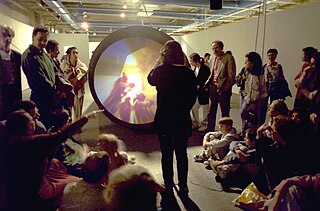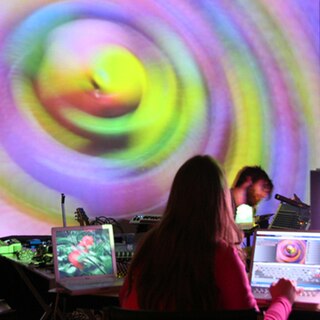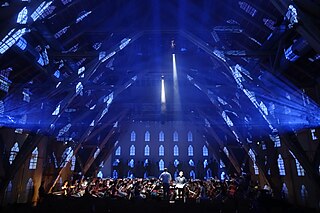
Coldcut are an English electronic music duo composed of Matt Black and Jonathan More. Credited as pioneers for pop sampling in the 1980s, Coldcut are also considered the first stars of UK electronic dance music due to their innovative style, which featured cut-up samples of hip-hop, soul, funk, spoken word and various other types of music, as well as video and multimedia. According to Spin, "in '87 Coldcut pioneered the British fad for 'DJ records'".
Multimedia is a form of communication that uses a combination of different content forms such as text, audio, images, animations, or video into a single interactive presentation, in contrast to traditional mass media, such as printed material or audio recordings, which features little to no interaction between users. Popular examples of multimedia include video podcasts, audio slideshows and animated videos. Multimedia also contains the principles and application of effective interactive communication such as the building blocks of software, hardware, and other technologies. The five main building blocks of multimedia are text, image, audio, video, and animation.
Video art is an art form which relies on using video technology as a visual and audio medium. Video art emerged during the late 1960s as new consumer video technology such as video tape recorders became available outside corporate broadcasting. Video art can take many forms: recordings that are broadcast; installations viewed in galleries or museums; works streamed online, distributed as video tapes, or DVDs; and performances which may incorporate one or more television sets, video monitors, and projections, displaying live or recorded images and sounds.

Digital art refers to any artistic work or practice that uses digital technology as part of the creative or presentation process. It can also refer to computational art that uses and engages with digital media.

Interactive art is a form of art that involves the spectator in a way that allows the art to achieve its purpose. Some interactive art installations achieve this by letting the observer walk through, over or around them; others ask the artist or the spectators to become part of the artwork in some way.
Visual effects is the process by which imagery is created or manipulated outside the context of a live-action shot in filmmaking and video production. The integration of live-action footage and other live-action footage or CGI elements to create realistic imagery is called VFX.
Sound design is the art and practice of creating soundtracks for a variety of needs. It involves specifying, acquiring or creating auditory elements using audio production techniques and tools. It is employed in a variety of disciplines including filmmaking, television production, video game development, theatre, sound recording and reproduction, live performance, sound art, post-production, radio, new media and musical instrument development. Sound design commonly involves performing and editing of previously composed or recorded audio, such as sound effects and dialogue for the purposes of the medium, but it can also involve creating sounds from scratch through synthesizers. A sound designer is one who practices sound design.
The term interactive video usually refers to a technique used to blend interaction and linear film or video.
Strictly, digital theatre is a hybrid art form, gaining strength from theatre's ability to facilitate the imagination and create human connections and digital technology's ability to extend the reach of communication and visualization.
Graphic design careers include creative director, art director, art production manager, brand identity developer, illustrator and layout artist.
Stephen Robert Dixon is a British actor and academic.

VJing is a broad designation for realtime visual performance. Characteristics of VJing are the creation or manipulation of imagery in realtime through technological mediation and for an audience, in synchronization to music. VJing often takes place at events such as concerts, nightclubs, music festivals and sometimes in combination with other performative arts. This results in a live multimedia performance that can include music, actors and dancers. The term VJing became popular in its association with MTV's Video Jockey but its origins date back to the New York club scene of the 1970s. In both situations VJing is the manipulation or selection of visuals, the same way DJing is a selection and manipulation of audio.

Audiovisual (AV) is electronic media possessing both a sound and a visual component, such as slide-tape presentations, films, television programs, corporate conferencing, church services, and live theater productions.

Marita Liulia is a visual artist working primarily in interactive multimedia. Her debut CD-ROM Maire (1994) was among the first works of art published in this format in the world. Her production includes multi-platform media artworks, photography, paintings, short films, books and stage performances. Her works have been exhibited and performed in 50 countries and she has received numerous international awards. Liulia first became interested in photography, painting, experimental film and cultural history while studying at Savonlinna Upper Secondary School of Art and Music. She continued her artistic studies at the University of Art and Design Helsinki, and broadened her horizons also by studying aesthetics, literature and political history at the University of Helsinki, graduating with a Bachelor of Arts in 1986.

Video design or projection design is a creative field of stagecraft. It is concerned with the creation and integration of film, motion graphics and live camera feed into the fields of theatre, opera, dance, fashion shows, concerts and other live events. Video design has only recently gained recognition as a separate creative field. For instance, United Scenic Artists' Local 829, the union that represents designers and scenic artists in the US entertainment industry, only added the Projection Designer membership category in 2007. Prior to this, the responsibilities of video design would often be taken on by a scenic designer or lighting designer. A person who practices the art of video design is often known as a Video Designer. However, naming conventions vary around the world, and so practitioners may also be credited as Projection Designer, "Media Designer", Cinematographer or Video Director. As a relatively new field of stagecraft, practitioners create their own definitions, rules and techniques.

New media art includes artworks designed and produced by means of electronic media technologies, comprising virtual art, computer graphics, computer animation, digital art, interactive art, sound art, Internet art, video games, robotics, 3D printing, and cyborg art. The term defines itself by the thereby created artwork, which differentiates itself from that deriving from conventional visual arts. New Media art has origins in the worlds of science, art, and performance. Some common themes found in new media art include databases, political and social activism, Afrofuturism, feminism, and identity, a ubiquitous theme found throughout is the incorporation of new technology into the work. The emphasis on medium is a defining feature of much contemporary art and many art schools and major universities now offer majors in "New Genres" or "New Media" and a growing number of graduate programs have emerged internationally. New media art may involve degrees of interaction between artwork and observer or between the artist and the public, as is the case in performance art. Yet, as several theorists and curators have noted, such forms of interaction, social exchange, participation, and transformation do not distinguish new media art but rather serve as a common ground that has parallels in other strands of contemporary art practice. Such insights emphasize the forms of cultural practice that arise concurrently with emerging technological platforms, and question the focus on technological media per se. New Media art involves complex curation and preservation practices that make collecting, installing, and exhibiting the works harder than most other mediums. Many cultural centers and museums have been established to cater to the advanced needs of new media art.
Indigenous Futurism is a movement consisting of art, literature, comics, games, and other forms of media which express Indigenous perspectives of the future, past, and present in the context of science fiction and related sub-genres. Such perspectives may reflect Indigenous ways of knowing, traditional stories, historical or contemporary politics, and cultural realities.
The conservation and restoration of performance art is the process of documenting, collecting, and prolonging the life of Performance Art. Performance Art often features a live presentation initially documented by an artist, cultural institution, or host location. This genre of art can take place in a wide range of mediums, and is usually based on four core elements: Time, Space, the Performer's body, and the relationship between viewers and performer. These variables determine how it can be collected and conserved within museums or cultural institutions.
Volumetric capture or volumetric video is a technique that captures a three-dimensional space, such as a location or performance. This type of volumography acquires data that can be viewed on flat screens as well as using 3D displays and VR goggles. Consumer-facing formats are numerous and the required motion capture techniques lean on computer graphics, photogrammetry, and other computation-based methods. The viewer generally experiences the result in a real-time engine and has direct input in exploring the generated volume.







